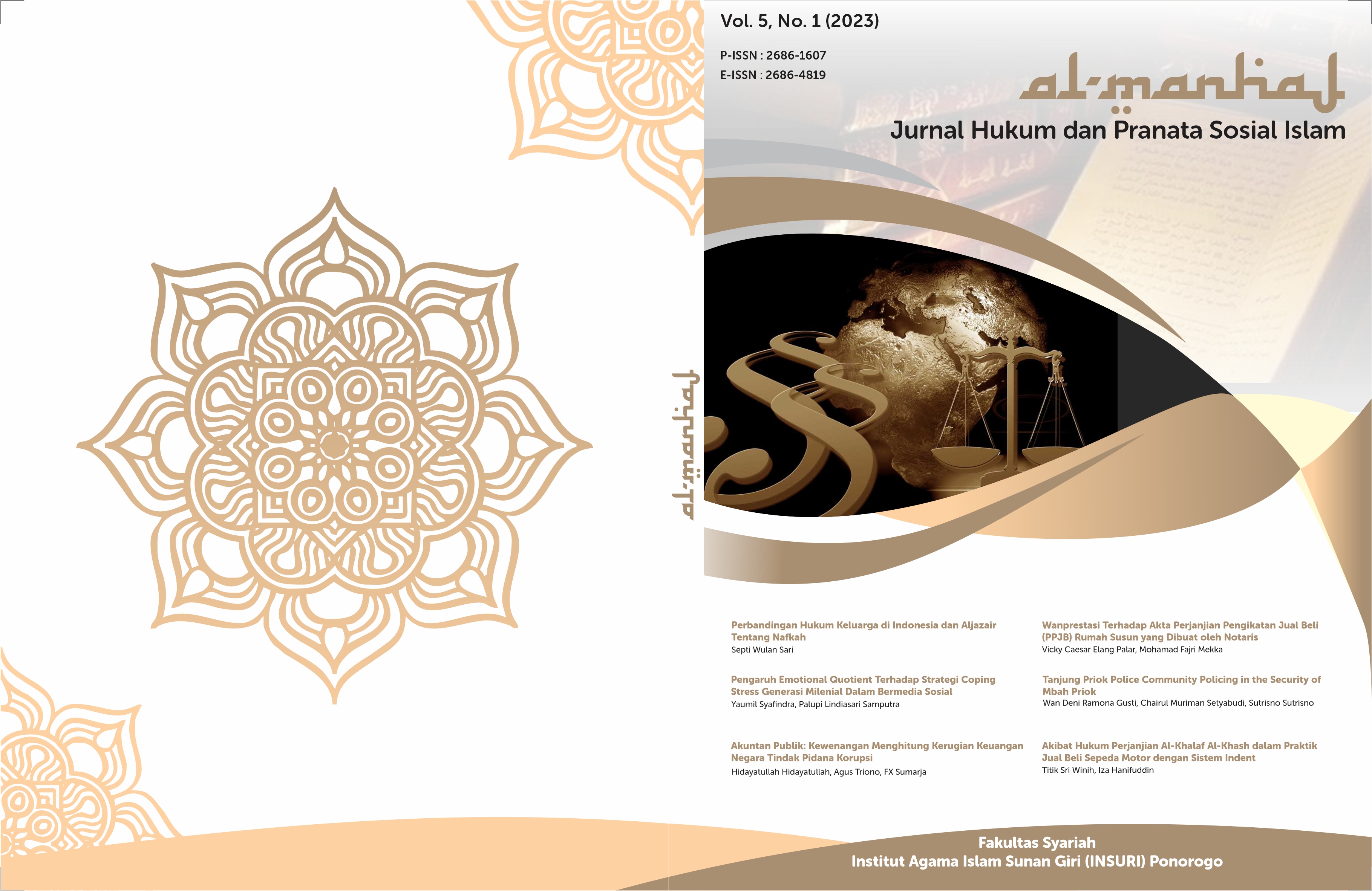Akad Pernikahan Melalui Zoom dalam Perspektif Fikih
DOI:
https://doi.org/10.37680/almanhaj.v5i1.2181Keywords:
Law; online marriage; the opinion of the clergyAbstract
The modern era is greatly facilitated by using technology. This is a shortcut to take advantage of technology, one of which is reducing distance and time facilitating communication between people without meeting each other. So that it becomes a new innovation in terms of marriage through Zion technology which makes it easier for the bride and groom who don't have to be in the same place. lighten the burden on the bride and groom in traveling expenses. But this raises questions as well as the views of various scholars and groups, because there was no law in ancient times. The purpose of this study is to find out the law of marriage contracts through zoom in the view of the scholars. The method used in this study uses the Library Research method and literature that is aligned with the theme. The results of this study are that, according to the Hanafi school of thought, online marriage is permissible because it is confirmed by the Prophet's Hadith that the Prophet SAW once performed a marriage using a piece of paper and in a different place between the bride and groom, supported by the MUI fatwa. However, according to the view of the Syafii school of thought, this is not permissible because the bride and groom must be in the same place.
References
Ahmad, Al-Qadhi Abu Syuja. 2018. Fiqih Sunnah Imam Syafii. Jakarta: Fathan Media Prima.
Al-Hanafi, Abu Bakr bin Mas’ud al-Kasani. 1996. Al-Bada’i Al-Sana’i F i Tartib Al-Syara’i. Beirut: Dar al-Fikri.
Al-Jaziri, Abdurrahman. 1990. Al-Fiqh Ala Mazahib Al-Arba’ah. Beirut: Dar al-Fikri.
Al-Syarakhsi, Syamsuddin. 1993. Al-Mabsu. V. Beirut: Dar al-al-Kitab Ilmiyah.
Alimuddin. 2011. Kompilasi Hukum Islam Sebagai Hukum Terapan Bagi Hakim Pengadilan Agama. Makassar: Alauddin University Press.
An-Nawawi. 1994. Al-Majmµ’ Syarah Muhażżab. XVI. Beirut: Dar al-Fikri.
Anon. n.d. “Al-Mustadrak.” Retrieved October 25, 2022 (http;//www. Al-sunnah.com).
Asy’ash, Abu Dawud Sulaiman bin. 1995. Sunan Abu Dawµd. Beirut: Dar Kitab al-Arabi.
Ayyub, Syaikh Hasan. n.d. Fikih Keluarga: Panduan Membangun Keluarga Sakinah Sesuai Syari‟a. Jakarta: Pustaka Al-Kautsar.
Bik, Muhammad Khudarii. 1966. Al-U¡µl Al-Fiqhi. Mesir: Al-Maktabah at-Tijarah alKubra.
Farid, Miftah. 2018. “Nikah Online Dalam Perspektif Hukum.” Jurisprudentie V.
Ghozali, Abdul Rahman. 2003. Fiqh Munakahat. Jakarta: Kencana Prenada Media Group.
Hakim, Abdul Hamid. 1976. Mabadi Awaliyah. Jakarta: Bulan bintang.
Harahap, Khairuddin Soleh. 2021. “Akad Nikah Daring Saat Wabah Covid-19 Menurut Mazhab Hanafi Dan Mazhab Syafi’i.” UIN Sumatera Utara.
Hasan, M. Ali. 2003. Pedoman Hidup Berumah Tangga Dalam Islam. Jakarta: Siraja.
Indonesia, Direktorat Utama Pembinaan dan Pengembangan Hukum Pemeriksaan Keuangan Negara Badan Pemeriksa Keuangan Republik. n.d. “Undang-Undang (UU) Tentang Perkawinan," JDIH BPK RI,.” Retrieved (https://peraturan.bpk.go.id/Home/Details/47406/uu-no-1-tahun-1974.).
Indonesia, Majelis Ulama. 2015. Himpunan Fatwa MUI Bidang Sosial Dan Budaya. Jakarta: Erlangga.
Khallaf, Abdul Wahab. 1997. Ilmu Ushul Fikih Kaidah Hukum Islam. A. Ma’ruf. Kuwait: Dar al-Qalam.
Mathlub, Abdul Majid Mahmud. 2005. Panduan Hukum Keluarga Sakinah. 1st ed. Surakarta: Era Intermedia.
Mughniyah, Muhammad Jawad. 2011. Fiqih Lima Mazhab. Jakarta: Lentera.
Musa, Muhammad Yusuf. 1958. AL- Ahwl Syakhsyiah. Mesir: Dar al-Qalam.
Rifa‟i, Moh. 1978. Fiqih Islam. Semarang: Karya Toha Putra.
Sabiq, Sayyid. 2009. Fiqih Sunnah. Jakarta: Pena Pundi Aksara.
Sabir, Muhammad. 2015. “Pernikahan Via Telepon.” Jurnal Al-Qadāu 2.
Syarifuddin, Amir. 2007. Hukum Perkawinan Islam Di Indonesia. Jakarta: Kencana.
Tihami, Sohari Sahrani. 2014. Fiqih Munakat. Jakarta: Rajawali.
Wiston, Kenny. n.d. “Nikah Online Menurut Hukum Islam Dan Implikasi Pencatatannya.” Retrieved December 25, 2022 (https://www.kennywiston.com/nikah-online-menurut-hukum-islam-dan-implikasi-pencatatann).
Downloads
Published
How to Cite
Issue
Section
License
Copyright:
- Author retains the copyright and grants the journal the right of first publication of the work simultaneously licensed under a Creative Commons Attribution 4.0 International License that allows others to share the work with an acknowledgment of the work's authorship and initial publication in this journal.
- Author is able to enter into separate, additional contractual arrangements for the non-exclusive distribution of the journal's published version of the work (e.g., post it to an institutional repository or publish it in a book) with the acknowledgment of its initial publication in this journal.
- Author is permitted and encouraged to post his/her work online (e.g., in institutional repositories or on their website) prior to and during the submission process, as it can lead to productive exchanges, as well as earlier and greater citation of the published work (See The Effect of Open Access).
License:
-
Attribution — You must give appropriate credit, provide a link to the license, and indicate if changes were made. You may do so in any reasonable manner, but not in any way that suggests the licensor endorses you or your use.
-
No additional restrictions — You may not apply legal terms or technological measures that legally restrict others from doing anything the license permits.
You are free to:
- Share — copy and redistribute the material in any medium or format
- Adapt — remix, transform, and build upon the material for any purpose, even commercially.

This work is licensed under a Creative Commons Attribution 4.0 International License.














